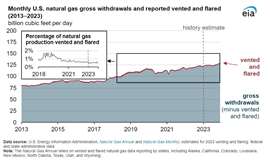Report: Flaring, venting in U.S. hit 18-year low
June 26, 2024
Decline seen even though natural gas production has increased
The U.S. Energy Information Agency (EIA) estimates natural gas vented or flared in 2023 hit an 18-year low.
According to the EIA, the annual reported volume of natural gas that is vented or flared in the United States declined to 0.5% of gross withdrawals in 2023, based on preliminary state and federal data.
Oil and natural gas producers and operators of facilities vent or flare natural gas in response to emergencies, safety tests, maintenance and repairs, or infrastructure constraints. When pipeline takeaway capacity is limited, for example, operators sometimes vent or flare natural gas that cannot be economically stored, depending on the regulations in the states in which they operate.
Methane can also leak from oil and natural gas installations, but leaks are not typically captured in the venting and flaring data reported, the EIA said.

The percentage of natural gas that is vented or flared can vary greatly across individual wells and producing regions due to different regulations and infrastructure constraints. The rate of natural gas vented or flared in the United States has decreased from 1.3% in 2018 and 2019 to an estimated 0.5% in 2023, even though natural gas production increased over the same period to a record average of 125.0 billion cubic feet per day (Bcf/d) in 2023. During this time, the reported share of natural gas vented and flared as a percentage of gross withdrawals for individual states has ranged from less than 0.1% on an annual basis in several states to as much as 19.3% in North Dakota in 2019, or from less than 0.1 Bcf/d to 0.7 Bcf/d.
The states with the most reported vented and flared natural gas are Texas, North Dakota, and Wyoming. In 2023, North Dakota, Wyoming, and California, as well as the Federal Offshore Gulf of Mexico, have the highest rates of reported vented or flared natural gas relative to their gross withdrawals of natural gas. In 2023, operators in North Dakota flared 5.1% of gross withdrawals, and those in Wyoming vented and flared 4.4% of their gross withdrawals. Combined, this rate amounts to 0.3 Bcf/d of the two states’ 6.5 Bcf/d of gross withdrawals, or about half of the volume of vented or flared natural gas in the United States reported in 2023 so far.
North Dakota has had high rates of venting and flaring since 2006 because associated natural gas production in the Bakken region grew more quickly than natural gas production and processing facilities, as well as pipeline takeaway capacity. North Dakota banned the venting of natural gas in 2014 and has captured more natural gas over the last decade, decreasing the share of natural gas flared from 31.6% in 2011 as natural gas production and processing facilities and pipeline takeaway capacity increased.
MAGAZINE
NEWSLETTER
CONNECT WITH THE TEAM






